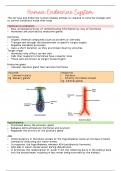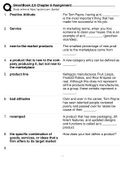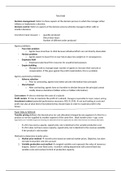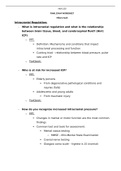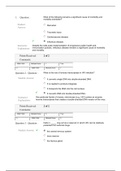The nervous and endocrine system enables animals to respond to external changes and
to control conditions inside their body
Chemical Co-ordination
- Slow, prolonged process of communicating information by way of hormones
- Hormones are secreted by endocrine glands
Hormones
- Organic chemical compounds (such as proteins or steroids)
- Transported through the bloodstream to specific target organs
- Regulate metabolic processes
- Have a short duration, as they are broken down by enzymes
Target organ
- Hormones only affect certain cells
- Cells that respond to hormones have receptor sites
- These cells are known as target tissue/organs
Endocrine gland
- Vascular, ductless gland that secretes hormones
Exocrine Endocrine
- Carried in ducts - Ductless
Eg. Salivary glands - Directly into blood stream
Eg. Adrenal glands
-
Duct Blood
flow
un
Endocrine
cell
Horomone
Exocrine
cell
Secretory
Product
Blood
Exocrine Gland vessels
Endocrine Gland
Hypothalamus
- Positioned above the pituitary gland
- Releases ADH (antidiuretic hormone) and oxytocin
- Regulates the activity of the pituitary gland
ADH
- Osmoreceptors in the blood vessels of the hypothalamus sense an increase in blood
osmolarity (indicating low water levels).
- In response, the hypothalamus releases ADH (antidiuretic hormone).
- ADH aids in water conservation during dehydration.
- It promotes the reabsorption of water from the collecting ducts in the kidneys back
into the bloodstream, resulting in less water being excreted by the kidneys.
,Pituitary gland
- Attached to hypothalamus
Hormones secreted by the pituitary gland
1. Thyroid stimulating hormone (TSH) *
- Stimulates thyroid to secrete thyroxin
2. Follicle stimulating hormone (FSH) *
- Females: stimulates oogenesis in the ovary (formation of eggs)
- Males: stimulates spermatogenesis in testes (sperm formation)
-
3. Luteinizing hormone (LH)
- Stimulates ovulation (release of an egg)
4. Prolactin *
- Stimulates the production of milk in the female mammary glands
5. Adrenocorticotropic hormone (ACTH)
- Stimulates the adrenal cortex to secrete cortisone and aldosterone
6. Interstitial cell stimulating hormone (ICSH)
- Stimulates the testes to secrete testosterone
7. Growth hormone (GH) or (STH - somatotropic hormone) *
- Promotes skeletal and muscular growth by stimulating synthesis of proteins
Growth disorders
Hypersecretion: over secretion of hormone
Hyposecretion: under secretion of hormone
In prepubertal children
- Hypersecretion of GH (growth hormone) results in overdevelopment of skeleton
leading to gigantism
- Hyposecretion of GH results in the underdevelopment of the skeleton leading to
pituitary dwarfism
o Reduced height
o Sexually immature
In adults Hypersecretion of GH leads to acromegaly where bones of face, hands and feet
are enlarged
Thyroid gland
- Hormone secreted is thyroxin
Functions
1. Increase basal metabolic rate (and therefore body heat) it does this by controlling
the rate of cellular respiration
2. Promotes normal functioning of the heart
3. Promotes normal functioning of the nervous system by increasing nervous
activity and sharpening alternes and reflexes
Disorders
Hypothyroidism: too little thyroxin resulting in low metabolic rate
- In adults this results in myxoedema (condition of mental and
physical sluggishness, low blood pressure/ body temperature and
, slow heart and respiratory rate)
- In children this results in cretinism (condition in which the child does not grow, has
immature sexual development and is mentally retarded)
Hyperthyroidism: too much thyroxin resulting in high metabolic rate (resulting in high
body temperature and increased sweating, increase in heart/ respiratory rate and blood
pressure, nervousness, swollen thyroid gland known as an exophthalmic goitre)
Keeping thyroxin in the blood constant
- This is done by a mechanism called negative feedback
1. The pituitary detects a decreased level of thyroxin in the
blood, so it secretes more TSH
2. TSH stimulates the thyroid to secrete more thyroxin, returning its level to normal
3. Higher levels of thyroxin inhibits further secretion of TSH from the pituitary
The negative feedback mechanism will therefore insure that the level of thyroxin in the
blood is kept at the correct level (set point) at all times
Homeostasis and negative feedback control
- Tissue fluid and blood are extracellular fluids
- Together they form the internal environment of the body
- For cells to function properly, internal factors must remain constant
- The process of maintaining the internal environment is called homeostasis
Maintaining homeostasis
- To maintain homeostasis, an individual must detect any changes from set point and
then correct this change
- Negative feedback enables an individual to maintain homeostasis
- When a change from setpoint of any factor is corrected by bringing about a change
in the opposite direction
Negative feedback system is made up of
- receptor that detects a change from the set point and sends information to the brain
- control centre processes the information and activates corrective mechanism that it
sends to the effector
- effector responds and corrects the change, returning the condition to set point
Pancreas
- Has both endocrine and exocrine glands
o Endocrine: section of hormones by groups of cells calls islets of Langerhans, the
hormones they secrete pass directly into the blood
o Exocrine: secretion of pancreatic juice, flows along the pancreatic duct into the
duodenum where it helps chemical digestion
Islets of Langerhans
- Alpha cells secrete glucagon
- Beta cells secrete insulin
Functions
- Control the level of blood sugar / glucose in the blood
- Glucose (simple sugar) derived from digesting carbohydrates, is a source of cellular
energy
- Transported in bloodstream and cannot enter cells without the aid of insulin
o Insulin lowers blood glucose level (accelerates the diffusion of glucose into cell)
, o Glucagon raises blood glucose level (accelerates the conversion of glucagon to
glucose)
- Insulin and glucagon have antagonistic effects
How insulin lowers blood glucose levels
1. After a meal, blood glucose levels rise above normal set point
2. When this blood with a higher glucose level passes through the pancreas, the beta
cells detect the raised glucose levels and respond by secreting insulin into the blood
3. Insulin goes to the liver and muscles
a. Makes cell membrane more permeable to glucose, which enables glucose to
leave the blood and enter the cells
b. Increase the rate at which glucose is converted into glycogen in the cells
4. As glucose leaves the blood, the blood glucose levels are lowered
5. This lowered glucose level is detected by the insulin secreting cells which then stop
realising insulin into the blood
How glucagon increases blood glucose
- Glucose level in the blood is low when you wake up or after you exercise
- When this low glucose blood passes through the pancreas, alpha cells (glucagon
secreting) detect the low glucose level and respond by secreting glucagon into the
blood
- Liver cells where glucagon causes the breakdown of stored glucagon into glucose
- Liver releases glucose into the blood, increasing the blood glucose level
- Increased glucose level is detected by glucagon secreting cells, which stop releasing
glucagon into the blood
Diabetes
- Disease characterized by high levels of glucose in the blood
Type 1 diabetes (insulin dependent)
- Usually starts in childhood
- Symptoms: tiredness, dilute urine containing glucose, great thirst
Cause
- Type 1 is an auto immune disease as body's immune system destroys the insulin-
producing beta cells in the pancreas
- Therefore the pancreas does not make insulin
- Glucose therefore remains in the blood instead of moving into the cells, this is known
as hypercalcemia
Treatment
- Proper diabetic management and regular exercise the disease can be controlled
- Routine daily injection of insulin
- Test blood glucose level frequently
Short term effects Long term effects
- Extreme thirst, nausea, vomiting, - Blindness, kidney failure, amputation of
dehydration, dizziness and a coma the limbs, increased risk of heart
attack and stroke
Type 2 diabetes (non-insulin dependent)
- Usually starts in adulthood
- Directly influenced by lifestyle
Cause
- Develops when the body produces less insulin or is not able to use the insulin correctly

